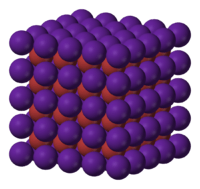Caesium bromide
 | |
| Names | |
|---|---|
| IUPAC name
Caesium bromide | |
| Other names
Cesium bromide, Caesium(I) bromide | |
| Identifiers | |
| 7787-69-1 | |
| ChemSpider | 22994 |
| EC number | 232-130-0 |
| |
| Jmol-3D images | Image |
| PubChem | 24592 |
| |
| Properties | |
| CsBr | |
| Molar mass | 212.81 g/mol |
| Appearance | White solid |
| Density | 4.44 g/cm3, solid |
| Melting point | 636 °C (1,177 °F; 909 K) |
| Boiling point | 1,300 °C (2,370 °F; 1,570 K) |
| 1062 g/L (15 °C) 1243 g/L (25 °C) | |
| Structure | |
| Crystal structure | CsCl |
| 8–8 | |
| Hazards | |
| EU Index | Not listed |
| Flash point | Non-flammable |
| LD50 (Median lethal dose) |
1400 mg/kg (oral, rat)[1] |
| Related compounds | |
| Other anions |
Caesium fluoride Caesium chloride Caesium iodide Caesium astatide |
| Other cations |
Sodium bromide Potassium bromide Rubidium bromide |
| Except where noted otherwise, data is given for materials in their standard state (at 25 °C (77 °F), 100 kPa) | |
| | |
| Infobox references | |
Caesium bromide, (CsBr), is an ionic compound of caesium and bromine. It has simple cubic p-type cubic crystallic structure, comparable to that of caesium chloride type with space group Pm3m and lattice constant a = 0.42953 nm. The distance between Cs+ and Br− ions is 0.37198 nm.
Synthesis
It can be prepared via following reactions:
- CsOH (aq) + HBr (aq) → CsBr (aq) + H2O (l)
- Cs2(CO3) (aq) + 2 HBr (aq) → 2 CsBr (aq) + H2O (l) + CO2 (g)
- Direct synthesis:
- 2 Cs (s) + Br2 (g) → 2 CsBr (s)
The direct synthesis is a vigorous reaction of caesium with other halogens. Due to its high cost, it is not used for preparation.
Uses
Caesium bromide is sometimes used in optics as a beamsplitter component in wide-band spectrophotometers.
See also
References
External links
- MSDS at Oxford University
- Physical data, Crystran PDF version, PDF version
- Caesium bromide at webelements.com
- Relaxed Excited States Origin and Structure in Lead-Doped Caesium Bromide
- IR transmission spectrum
- Ultra-violet photoabsorption measurements in alkali iodide and caesium bromide evaporated films
| ||||||